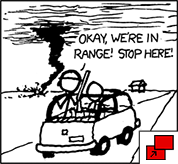Meet the VORTEX2 Team
Note: Information about specific vehicle and instrument teams may be found here.
Sponsors
Participating organizations
- Rasmussen Systems

- The Center for Severe Weather Research
 (CSWR)
(CSWR) - National Severe Storms Laboratory (NSSL)
- Penn State University
 (PSU)
(PSU) - The University of Oklahoma
 (OU)
(OU) - OU Cooperative Institute for Mesoscale Meteorological Studies
 (CIMMS)
(CIMMS) - OU Center for the Analysis and Prediction of Storms
 (CAPS)
(CAPS) - The University of Colorado
 (CU)
(CU) - North Carolina State University
 (NCSU)
(NCSU) - Texas Tech University
 (TTU)
(TTU) - National Center for Atmospheric Research
 (NCAR)
(NCAR) - Lyndon State College

- University of Massachusetts

- Environment Canada

- University of Nebraska
 (UNL)
(UNL) - Purdue University

- University of Michigan

- State University of New York at Oswego

- Australian Bureau of Meteorology

- Finnish Meteorological Institute

- ProSensing, Inc.

Steering committee
- Howard Bluestein, University of Oklahoma
- Howie Bluestein is Professor of Meteorology at the University of Oklahoma. Dr. Bluestein is fascinated by all sorts of weather phenomena, particularly those of a violent nature. His research interests are the observation and physical understanding of weather phenomena on convective, mesoscale, and synoptic scales.
- Don Burgess, OU/CIMMS
- Don Burgess is a retired federal research meteorologist and now part-time with OU/CIMMS. Burgess pioneered the concept of "nowcasting" by using radar to direct an NSSL research team during a tornado intercept and lead the discovery of the "tornado vortex signature" seen in radar displays.
- David Dowell, NCAR
- Dr. Dowell has had a long-time interest in tornadoes and other storms, always with an eye toward better understanding of the internal structure of tornadoes and ultimately learning more about how they form.
- Paul Markowski, PSU
- Dr. Markowski's current research interests includes using mobile, dual-Doppler radar observations to better understand the processes associated with tornadogenesis and its failure.
- Erik Rasmussen, Rasmussen Systems
- Dr. Rasmussen lead the original VORTEX field project, and formed Rasmussen Systems to host a variety of research and consulting activities. Rasmussen's severe weather research is supported by NSF.
- Yvette Richardson, PSU
- Dr. Richardson's research interests include convective storms and their interaction with mesoscale features in their environments, tornadogenesis, radar observations of tornadic thunderstorms, convective initiation, and numerical modeling
- Lou Wicker, NSSL
- Dr. Wicker was part of the collaboration that developed the Shared Mobile Atmospheric Research and Teaching Radar (SMART-Radar) and is passionate about increasing our understanding of tornadogenesis, supercell processes and severe storms, and then help get that knowledge applied to real world problems.
- Joshua Wurman, CSWR
- Dr. Wurman designed the Doppler On Wheels mobile radars to observe tornadoes, hurricanes and other phenomena from close range. He is President of the Center for Severe Weather Research located in Boulder, Colorado.

Principal Investigators
(In roughly alphabetical order)
- Center for Severe Weather Research
- Joshua Wurman
Karen Kosiba - Cooperative Institute for Mesoscale Meteorological Studies
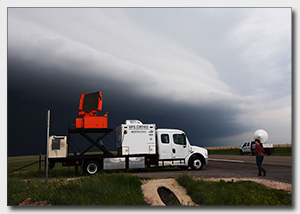
photo courtesy Jeff Snyder
- Don Burgess
- Lyndon State
- Nolan Atkins
- National Center for Atmospheric Research
- George Bryan
David Dowell
Glen Romine
Roger Wakimoto
Morris Weisman - NOAA National Severe Storms Laboratory
- Mike Coniglio
Pam Heinselman
Ted Mansell
Dave Rust
Louis Wicker
Conrad Ziegler - NOAA Warning Decision Training Branch
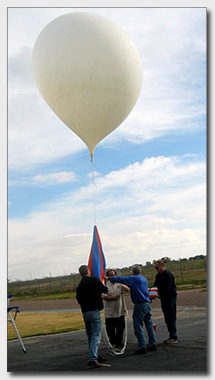
- Jim Ladue
Mike Magsig - North Carolina State University
- Matt Parker
- Penn State University
- Paul Markowski
Yvette Richardson - Purdue
- Jeff Trapp
- Rasmussen Systems
- Erik Rasmussen
- Texas Tech University
- Chris Weiss
- University of Colorado
- Brian Argrow
Jack Elston
Eric Frew
Katja Fredrich - University of Massachusetts
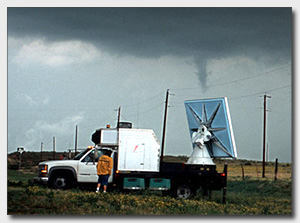
- Steve Frasier
- University of Nebraska at Lincoln
- Adam Houston
- University of Oklahoma
- Mike Biggerstaff
Howie Bluestein
Katherine Kanak
Jerry Straka
Ming Xue
VORTEX2 International Principal Investigators
- Environment Canada
- Neil Taylor
David Sills
Other Significant Partners to work in operations or field
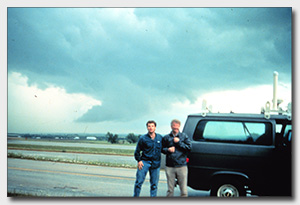
- NOAA Earth System Research Lab
- Curtis Alexander
Stan Benjamin
Tracy Lorraine-Smith
Steve Weygandt - NOAA National Weather Service Norman, Okla.
- Mike Foster
- NOAA National Weather Service San Diego, Calif.
- Jim Purpura
- NOAA Storm Prediction Center
- National Center for Atmospheric Research Earth Observing Lab (MGaus mobile soundings systems)


